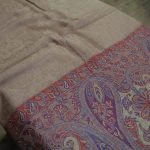In the world of fashion, where trends come and go like fleeting moments, some treasures stand the test of time, becoming synonymous with opulence and sophistication. One such embodiment of timeless elegance is the Handmade Shahtoosh Shawl. Crafted with meticulous precision and centuries-old techniques, these shawls are not just accessories; they are works of art that transcend fashion seasons. In this exploration, we delve into the unparalleled luxury of Handmade Shahtoosh Shawls, tracing their rich history, intricate craftsmanship, and the sheer indulgence they bring to those fortunate enough to possess them.
The History:
To understand the luxury of Handmade Shahtoosh Shawls, one must first immerse themselves in the rich tapestry of history that surrounds these exquisite pieces. Originating from the remote regions of the Himalayas, particularly in the Changthang plateau, these shawls have a heritage that dates back centuries. The name "Shahtoosh" itself translates to "King of Wool," a fitting title for a textile that was once exclusively reserved for royalty.
Woven from the underfur of the endangered Tibetan antelope, known as the Chiru, the making of Shahtoosh shawls involves a delicate and time-consuming process. The wool is so fine that a shawl can pass through a wedding ring, a testament to the unparalleled craftsmanship required to create such intricate textiles. The historical significance of Shahtoosh shawls lies not just in their luxurious appeal but also in the cultural and social traditions they embody.
The Craftsmanship:
At the heart of the allure of Handmade Shahtoosh Shawls lies the exceptional craftsmanship employed in their creation. Skilled artisans, often hailing from the same families for generations, carefully and patiently weave each shawl, employing techniques that have been handed down through the ages. The weaving process involves an intricate interplay of skill and artistry, with patterns ranging from traditional paisleys to geometric designs.
One of the most distinctive features of Shahtoosh shawls is their weightlessness. Despite being incredibly warm, these shawls are so finely woven that they are almost ethereal in their delicacy. The mastery required to achieve this balance of warmth and weightlessness is a testament to the artisan\'s skill and deep understanding of the craft.
The Ethical Dilemma:
As we revel in the luxury of Handmade Shahtoosh Shawls, it is essential to address the ethical concerns surrounding their production. The Chiru antelope, whose wool is used to create Shahtoosh shawls, is an endangered species protected under international law. Poaching for the sake of these exquisite textiles has contributed to the decline in the Chiru population, raising ethical questions about the sustainability of Shahtoosh shawl production.
Several initiatives and organizations are working towards creating ethical alternatives, such as using alternative materials or developing synthetic fibers that mimic the luxurious feel of Shahtoosh wool. As consumers, it is crucial to be aware of the ethical implications of our choices and support sustainable practices in the luxury industry.
The Rarity and Exclusivity:
The scarcity of the raw material, coupled with the intricate craftsmanship involved, contributes to the rarity and exclusivity of Handmade Shahtoosh Shawls. Each piece is a labor of love, taking months to complete, and the limited availability adds to the allure of owning such a coveted item.
The exclusivity of Shahtoosh shawls extends beyond their production process. These shawls have graced the shoulders of royalty and dignitaries throughout history, further elevating their status as symbols of prestige. Owning a Handmade Shahtoosh Shawl is not just a fashion statement; it is a declaration of refined taste and appreciation for the finer things in life.
Styling with Shahtoosh Shawls:
The versatility of Handmade Shahtoosh Shawls extends to their styling possibilities. Despite their delicate appearance, these shawls are surprisingly durable, making them suitable for both formal and casual occasions. Draped over an evening gown, a Shahtoosh shawl adds an element of regality, while paired with jeans and a simple top, it exudes effortless sophistication.
The neutral tones of Shahtoosh shawls make them easy to integrate into various wardrobes, allowing them to be passed down through generations as timeless heirlooms. The subtle elegance of these shawls makes them a statement piece that complements rather than overwhelms, making them a favorite among fashion connoisseurs worldwide.
Preserving the Tradition:
As we celebrate the luxury of Handmade Shahtoosh Shawls, it becomes imperative to discuss the efforts made to preserve the tradition and ensure the sustainability of this ancient craft. Artisan communities, along with government and non-governmental organizations, are working towards creating awareness about the ethical concerns surrounding Shahtoosh production. Additionally, initiatives to provide alternative sources of livelihood for communities involved in the craft are crucial for the long-term preservation of this heritage.
In conclusion, the luxury of Handmade Shahtoosh Shawls goes beyond the threads and weaving techniques. It is a celebration of history, craftsmanship, and the timeless elegance that accompanies each piece. While the ethical concerns surrounding the production of Shahtoosh shawls cannot be ignored, there is hope that sustainable alternatives will pave the way for the continued enjoyment of these luxurious textiles. In a world that often prioritizes fast fashion, the Handmade Shahtoosh Shawl stands as a reminder of the enduring beauty that comes with patience, skill, and a connection to cultural heritage.



